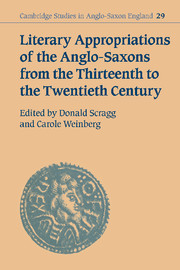Book contents
- Frontmatter
- Contents
- List of contributors
- Acknowledgements
- List of abbreviations
- Introduction. The Anglo-Saxons: fact and fiction
- 1 Victor and victim: a view of the Anglo-Saxon past in LaƷamon's Brut
- 2 Kings, constitution and crisis: ‘Robert of Gloucester’ and the Anglo-Saxon remedy
- 3 The South English Legendary: Anglo-Saxon saints and national identity
- 4 King Ælle and the conversion of the English: the development of a legend from Bede to Chaucer
- 5 Saxons versus Danes: the anonymous Edmund Ironside
- 6 New times and old stories: Middleton's Hengist
- 7 Crushing the convent and the dread Bastille: the Anglo-Saxons, revolution and gender in women's plays of the 1790s
- 8 Anglo-Saxon attitudes?: Alfred the Great and the Romantic national epic
- 9 ‘Utter indifference’?: the Anglo-Saxons in the nineteenth-century novel
- 10 The charge of the Saxon brigade: Tennyson's Battle of Brunanburh
- 11 Lady Godiva
- 12 The undeveloped image: Anglo-Saxon in popular consciousness from Turner to Tolkien
- Index of Anglo-Saxons mentioned in the text
- Index of authors and works cited
11 - Lady Godiva
Published online by Cambridge University Press: 21 September 2009
- Frontmatter
- Contents
- List of contributors
- Acknowledgements
- List of abbreviations
- Introduction. The Anglo-Saxons: fact and fiction
- 1 Victor and victim: a view of the Anglo-Saxon past in LaƷamon's Brut
- 2 Kings, constitution and crisis: ‘Robert of Gloucester’ and the Anglo-Saxon remedy
- 3 The South English Legendary: Anglo-Saxon saints and national identity
- 4 King Ælle and the conversion of the English: the development of a legend from Bede to Chaucer
- 5 Saxons versus Danes: the anonymous Edmund Ironside
- 6 New times and old stories: Middleton's Hengist
- 7 Crushing the convent and the dread Bastille: the Anglo-Saxons, revolution and gender in women's plays of the 1790s
- 8 Anglo-Saxon attitudes?: Alfred the Great and the Romantic national epic
- 9 ‘Utter indifference’?: the Anglo-Saxons in the nineteenth-century novel
- 10 The charge of the Saxon brigade: Tennyson's Battle of Brunanburh
- 11 Lady Godiva
- 12 The undeveloped image: Anglo-Saxon in popular consciousness from Turner to Tolkien
- Index of Anglo-Saxons mentioned in the text
- Index of authors and works cited
Summary
In 1857, for Prince Albert's thirty-eighth birthday Queen Victoria gave him ‘a gilded silver statuette of a nude Lady Godiva, side saddle on her horse’. Today we cannot be certain of the motivation behind the gift: was it a private token with erotic overtones between a wife and husband? Was it political, with Godiva's figure signifying Victoria's lifelong and heroic self-sacrifice for her subjects’ common good – a woman who forsook the private role society expected of the weaker sex in order to assume a public duty? Was it political in a marital sense, a sign of wifely submission to Albert, whose official title that very year had been announced as ‘Prince Consort’, permanently labelling him as the queen's social and political inferior? Was its appeal simply aesthetic? Whatever the motivation, Victoria's choice of a gift is an indication of the extent to which the Godiva legend had become domesticated by the nineteenth century. In an age that romanticized the medieval past (as other contributions to this volume demonstrate), Lady Godiva was a household name.
It is still a household name. I am convinced that the name ‘Godiva’ is more widely recognized around the world than that of any other Anglo-Saxon. The greatest irony of her post-medieval notoriety is that the historical Godiva was a pious and respectable countess who almost certainly never made the horseback ride through Coventry that legend attributes to her.
- Type
- Chapter
- Information
- Literary Appropriations of the Anglo-Saxons from the Thirteenth to the Twentieth Century , pp. 194 - 214Publisher: Cambridge University PressPrint publication year: 2000
- 2
- Cited by

